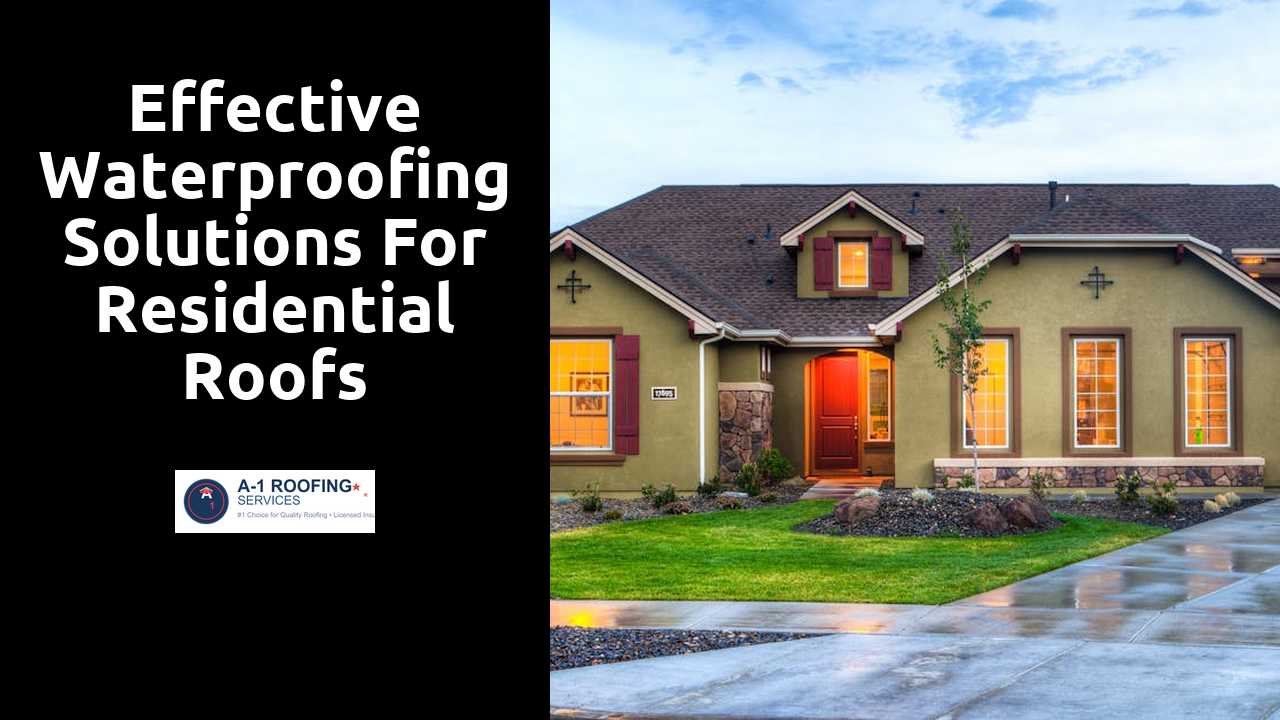
Effective Waterproofing Solutions for Residential Roofs
Table Of Contents
Choosing the Right Waterproofing Product
Selecting an appropriate waterproofing product involves understanding your specific roofing needs and the environmental conditions your home faces. Various materials are available, including liquid membranes, sheet membranes, and sealants. Each product has unique properties suited for different applications. For instance, liquid membranes often offer flexibility and strength, while sheet membranes can provide robust protection in high-traffic areas.
Consider the roofing material you have, such as asphalt, metal, or tiles. Compatibility is essential for effective adhesion and long-lasting performance. Many manufacturers provide detailed guidelines for their products, including the ideal surface preparations and environmental conditions for application. Prioritizing durability and UV resistance can extend the lifespan of your waterproofing solution. Be mindful of local climate factors as well, as these greatly impact the effectiveness of your chosen product.
Click here for additional info.
Factors to Consider for Your Home
When selecting a waterproofing solution, it is essential to assess the specific characteristics of your roof. The type of roofing material plays a significant role. Shingle roofs may require different products compared to flat roofs or metal roofing. Understanding the pitch and design of your roof can also influence your choice. Additionally, the climate in your region should be considered, as areas prone to heavy rain or snow may necessitate more robust waterproofing measures.
Another crucial factor is the condition of the existing roofing system. Inspecting for any damage, such as cracks or leaks, will help determine whether a repair is needed before waterproofing. Homeowners should also take into account their budget and the lifespan of the products available. Higher-quality waterproofing solutions may come with a greater initial investment but could provide long-term savings by minimizing the need for repairs and replacements. Evaluating these elements will guide homeowners in making an informed decision tailored to their specific needs.
DIY Waterproofing Techniques
Homeowners can take several approaches to ensure their roofs remain watertight. One effective technique involves applying a waterproof sealant. Such products can typically be found at home improvement stores. It is important to select a sealant that is specifically designed for roofing materials. Proper surface preparation is crucial. Cleaning the roof thoroughly eliminates debris and ensures better adhesion of the waterproof product.
Another popular DIY method includes the installation of a waterproof membrane. This type of membrane helps to create a barrier against moisture. It is essential to measure the roof accurately to ensure proper sizing of the membrane. Before installation, inspect for any existing damage that may need addressing. Following the manufacturer's instructions closely guarantees the best results and prolongs the lifespan of the waterproofing layer.
Step-by-Step Guide for Homeowners
Begin by assessing your roof’s current condition. Look for signs of damage, such as cracks, missing shingles, or mold growth. Clean the surface thoroughly to remove dirt, debris, and any old waterproofing material. This ensures optimal adhesion for the new product. Once the roof is clean, allow it to dry completely before applying any waterproofing solution.
After preparing the surface, choose a high-quality waterproofing product that suits your roof type. Follow the manufacturer's instructions carefully for application. Use a roller or sprayer to apply the solution evenly across the roof surface. Pay close attention to seams and edges, as these areas are more vulnerable to leaks. Allow the first coat to dry completely before applying additional layers if necessary, ensuring a robust barrier against water intrusion.
When to Hire a Professional
Homeowners may encounter situations that signal the need for professional assistance with waterproofing projects. Signs of extensive water damage or persistent leaks often indicate that the existing protection is inadequate. Trained roofing specialists have the expertise to assess both visible and hidden issues, determining the root causes of water infiltration. Additionally, roofs that are steep or complex may pose safety risks when it comes to DIY repairs, making professional intervention a safer option.
Another scenario that necessitates expert help is the lack of experience with waterproofing systems. Many modern waterproofing materials require specific application techniques to ensure effectiveness. A poorly executed DIY job can result in wasted materials and additional costs if the waterproofing fails. For significant projects, especially those involving multiple layers or the integration of various systems, consulting with a professional can ensure a proper installation and long-lasting results.
Key Indicators That Require Expert Help
Certain signs in your roofing system indicate that professional intervention is necessary. If you notice persistent leaks, even after trying DIY repairs, that suggests a more serious underlying issue. Discoloration or staining on ceilings and walls can point to prolonged water damage. Additionally, if your roof has visible sagging or large bubbles in the surface material, it may indicate trapped moisture or structural problems.
Another critical factor is the age of your roof. Older roofs often need more maintenance and are at a higher risk for significant water-related issues. If your roof has experienced extreme weather conditions, especially heavy rains or hail, this can exacerbate damage. In such cases, consulting with a roofing expert can save you time and prevent further complications. Regular inspections by professionals help identify potential problems before they escalate into costly repairs.
Related Links
Common Mistakes in Roof Waterproofing and How to Avoid ThemExpert Tips for Maintaining Waterproof Roofs